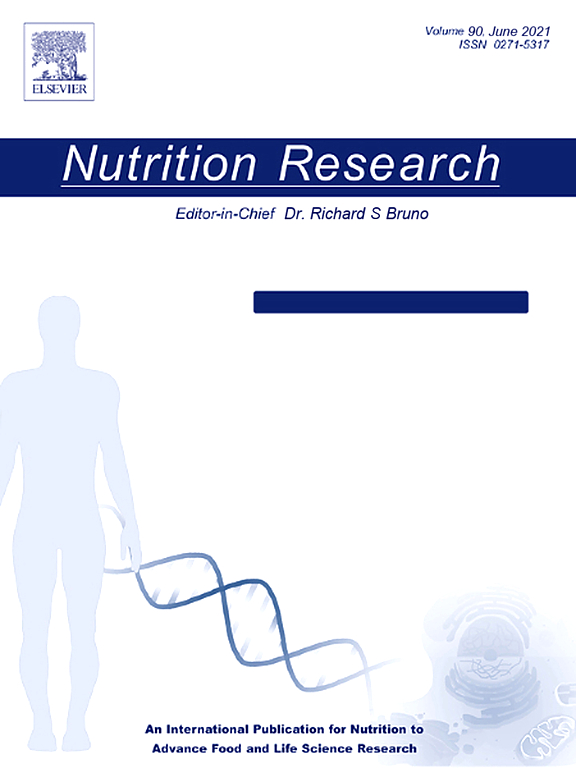美国国家健康与营养检查调查显示,代谢综合征与维生素C需求增加有关
IF 3.1
3区 医学
Q2 NUTRITION & DIETETICS
引用次数: 0
摘要
代谢综合征(MetS)包括一系列心脏代谢参数失调。这项研究在美国国家健康与营养调查(NHANES)中评估了MetS和维生素C之间的关系,以确定MetS严重程度人群的维生素C需求,假设MetS严重程度较高的人对维生素C的需求也较高。从NHANES 2003-6和2017-18中提取了未补充维生素C的空腹成年人(n = 4,832)的数据,包括人口统计学和生活方式变量、心脏代谢实验室变量、维生素C膳食摄入量和血清浓度。根据性别、腰围、收缩压、高密度脂蛋白胆固醇、甘油三酯和空腹血糖浓度计算MetS严重程度评分。该组MetS严重程度的平均(范围)评分为0.19(-4.0至6.8)。MetS严重程度评分与血清维生素C呈负相关(r=-0.203, p <;0.001)。达到维生素C充足阈值≥50µmol/L的参与者的平均MetS严重程度评分为0.00,而未达到阈值的参与者的平均MetS严重程度评分为0.38 (p <;0.001)。当按met严重程度评分分位数进行分组时,得分最高的参与者需要摄入100毫克/天,相当于额外的65毫克/天(或2.7倍的摄入量要求),以达到相对于得分最低的参与者的充足阈值。在个体MetS严重程度评分成分与维生素C状态和需求之间观察到可比较的关系。总的来说,结果表明,代谢失调的增加导致维生素C状态下降,维生素摄入量需要增加才能满足足够的循环浓度。本文章由计算机程序翻译,如有差异,请以英文原文为准。

Metabolic syndrome is associated with increased vitamin C requirements in the US National Health and Nutrition Examination Survey
Metabolic syndrome (MetS) comprises a constellation of dysregulated cardiometabolic parameters. This study assessed associations between MetS and vitamin C in the US National Health and Nutrition Examination Survey (NHANES) to determine vitamin C requirements in people with a range of MetS severity, the hypothesis being that people with higher MetS severity would have higher requirements for the vitamin. Data for non-supplementing, fasting adults (n = 4,832) was extracted from NHANES 2003-6 and 2017-18 and included demographic and lifestyle variables, cardiometabolic laboratory variables, vitamin C dietary intakes and serum concentrations. MetS severity score was calculated using sex, waist circumference, systolic blood pressure, HDL cholesterol, triglycerides and fasting glucose concentrations. The mean (range) MetS severity score for the group was 0.19 (-4.0 to 6.8). There was a negative association between MetS severity score and serum vitamin C (r=-0.203, p < 0.001). Participants who met the vitamin C adequacy threshold of ≥50 µmol/L had a mean MetS severity score of 0.00 vs 0.38 in those who did not meet the threshold (p < 0.001). When the group was stratified by MetS severity score tertiles, the participants with the highest scores required an intake >100 mg/d, equating to an additional 65 mg/d (or 2.7-fold higher intake requirement) to meet the adequacy threshold relative to those with the lowest scores. Comparable relationships were observed between the individual MetS severity score components and vitamin C status and requirements. Overall, the results indicate that increased metabolic dysregulation results in decreased vitamin C status and a higher intake requirement for the vitamin to meet adequate circulating concentrations.
求助全文
通过发布文献求助,成功后即可免费获取论文全文。
去求助
来源期刊

Nutrition Research
医学-营养学
CiteScore
7.60
自引率
2.20%
发文量
107
审稿时长
58 days
期刊介绍:
Nutrition Research publishes original research articles, communications, and reviews on basic and applied nutrition. The mission of Nutrition Research is to serve as the journal for global communication of nutrition and life sciences research on diet and health. The field of nutrition sciences includes, but is not limited to, the study of nutrients during growth, reproduction, aging, health, and disease.
Articles covering basic and applied research on all aspects of nutrition sciences are encouraged, including: nutritional biochemistry and metabolism; metabolomics, nutrient gene interactions; nutrient requirements for health; nutrition and disease; digestion and absorption; nutritional anthropology; epidemiology; the influence of socioeconomic and cultural factors on nutrition of the individual and the community; the impact of nutrient intake on disease response and behavior; the consequences of nutritional deficiency on growth and development, endocrine and nervous systems, and immunity; nutrition and gut microbiota; food intolerance and allergy; nutrient drug interactions; nutrition and aging; nutrition and cancer; obesity; diabetes; and intervention programs.
 求助内容:
求助内容: 应助结果提醒方式:
应助结果提醒方式:


